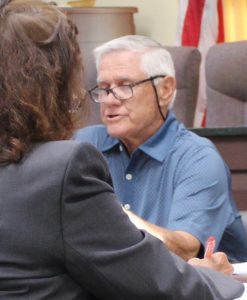Correction:
The print version of this story published in the July 27 issue of The Port Times Record incorrectly stated that the Village of Port Jefferson Treasurer’s Office remains vacant. In fact, Donald Pearce was confirmed 3-2 by the village Board of Trustees following an executive session July 24. We apologize for the error.
Amid the summer heat wave, tensions were even hotter inside Village Hall Monday night, July 24.
Members of the recently reorganized Village of Port Jefferson Board of Trustees sparred publicly for the second time this month, the board at first opting not to approve Mayor Lauren Sheprow’s choice for village treasurer.
A motion to appoint Donald Pearce over Denise Mordente, treasurer during the previous administration, was tabled 3-2. Deputy Mayor Rebecca Kassay joined trustees Stan Loucks and Bob Juliano to table the matter.
Loucks had left the reorganization meeting earlier this month over Sheprow’s decision denying him reappointment as trustee liaison to Port Jefferson Country Club. [See story, “Port Jeff village board cans code changes for Maryhaven, tensions flare amid reorganization,” July 13, The Port Times Record, also TBR News Media website.] He continued to critique Sheprow’s pattern of appointments.

“You have gotten rid of three and maybe more of the most loyal, hardworking and knowledgeable people” within the village government, Loucks told the mayor. “Now again, you’ve made a motion to get rid of Denise Mordente — this after telling her not more than five hours earlier that she was good as a treasurer and was safe.”
“It just seems to me that a person’s word no longer means anything,” he added.
Sheprow suggested that Pearce’s professional background and experience within PJV would facilitate his transition into the role. She added that the choice is a matter of staffing the government “with people who I know and trust to do a great job for the residents of the Village of Port Jefferson.”
Juliano, who had worked alongside Pearce during a prior administration, maintained his support for Mordente’s reappointment despite Pearce’s qualifications.
“I’m opposed to this not because I’m opposed to Don but because I am approving Denise,” he said.
Only trustee Drew Biondo joined Sheprow in the initial vote to appoint Pearce. Biondo likened a mayor staffing the government to a captain picking a team.
“I’ve been in politics my entire life, and that’s the way cookie crumbles,” he said. “The mayor gets to choose her team, and I’m inclined to give the mayor her team.”
Later in the night, following an executive session, Donald Pearce was confirmed 3-2 as village treasurer, effective Aug. 7. Kassay joined Sheprow and Biondo in approving the appointment.
Other business
The envisioned Six Acre Park along Highlands Boulevard advanced several procedural hurdles on the path toward grant funding.
The board unanimously approved a resolution establishing Port Jeff Village as the lead agency in developing the parkland and adopting a determination of nonsignificance under the State Environmental Quality Review Act.
Kassay said these steps were necessary for applying for the New York State Environmental Protection Fund’s Grant Program for Parks, Preservation and Heritage. The board expects a decision on its grant application by December.
With the Recreation Department at the height of camp season, Loucks urged his colleagues to begin conversations about expanding racket sports opportunities.
“It seems that tennis and pickleball are two of the most important activities, the most popular activities, through the Rec Department,” he said, adding that “250-plus youngsters [are] enrolled in each one of these sports. That’s over 500 on limited facilities.”
Loucks suggested redeveloping the racket sports area at Port Jefferson Country Club to accommodate more tennis and pickleball athletes.
“I fear that there have to be some decisions made shortly about the redevelopment of our racket complex up at that country club,” he added.
The board will reconvene Monday, Aug. 7, at 5 p.m.
















